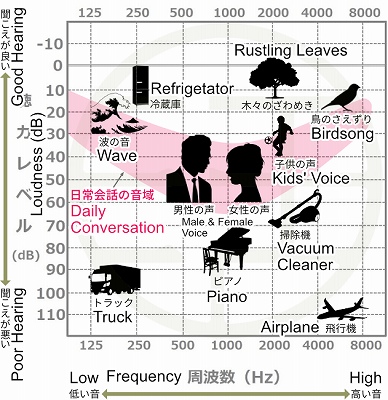How to read an Audiogram (2)
Now the second half of the article “How to read an Audiogram”. If you want to start from the previous post, you can click a link below.
Intensity (loudness) , frequency (pitch) of the sound and its relationship with daily life sound
Loudness and pitch are also indicated on an audiogram.
The vertical axis represents the intensity of sound (dB: decibels), and the horizontal axis represents frequency (Hz: hertz).
In a picture below, you can see where those sounds of daily life environment are located.
For example, ordinary human conversation is about between 30dB and 60dB, 500Hz and 2000Hz. That means our quality of life is directly affected by the hearing of 500Hz to 2000Hz.
You can’t hear the sound above the line connecting “〇” (and “✕“)
You start hearing the sound from the level marked with “〇” (and “✕”) on the audiogram.
Let’s see a colored audiogram below. Green is the range you can hear, in contrary red is the one you can’t hear (by air conduction). You don’t experience purely bone conduction hearing in your daily life unless you use bone conduction earphone.
Pure Tone Average (PTA) and the degree of hearing loss
Finally, we talk about Pure Tone Average (PTA) shown at the bottom of the audiogram. PTA is the average of hearing sensitivity at some selected frequencies (normally 500Hz, 1000Hz and 2000Hz). It is used for numerically showing hearing impairment for speech understanding.
 You can also see the words, “3FA”, “4FA” and “6FA”. “FA” means frequency average. In Japan, 4FA is commonly used as a reference of the degree of hearing loss.
You can also see the words, “3FA”, “4FA” and “6FA”. “FA” means frequency average. In Japan, 4FA is commonly used as a reference of the degree of hearing loss.
Let’s see how they are calculated.
How PTA is calculated
3FA
PTA (dB)=(500Hz+1000Hz+2000Hz)÷3
3FA is a method that emphasizes hearing between 500Hz and 2000Hz which is most used in our daily conversation.
4FA
PTA (dB)=(500Hz+1000Hz×2+2000Hz)÷4
or
PTA (dB)=(500Hz+1000Hz+2000Hz+4000Hz)÷4
The first one is a method that weights 1000Hz among other frequencies. In Japan, this is commonly used.
However, the world popular way is the second one. If you get tested in your country, the result value in 4FA would be on a different calculation from the one in Japan.
6FA
PTA (dB)=(500Hz+1000Hz×2+2000Hz×2+4000Hz)÷6
6FA is a method that weights 1000Hz and 2000Hz especially among others.
The degrees of hearing loss
In Japan, 4FA is commonly used as a reference of the degree of hearing loss.
25dB – 45dB: Mild Hearing Loss
One-on-one conversations are fine. But if you are aware of misunderstandings and having difficulty in hearing conversation in small voices and noisy environment, you may have mild hearing loss. Hearing aids may be indicated for the purpose of improving hearing in group meetings, etc.
40dB – 70dB: Moderate Hearing Loss
If you have misunderstandings and difficulty in hearing conversations in person and on the phone, you may have moderate hearing loss. You often need to ask people to repeat themselves. Hearing aids are effective in many cases.
70dB – 90dB: Severe Hearing Loss
At this level, You can’t hear other people speaking unless they’re extremely loud. Without use of the hearing aids or other amplification, it’s hard to hear people speaking.
90dB and above: Profound Hearing Loss
You may often not be able to hear even with hearing aids. Cochlear implant would be considered.
There are still criteria of hearing loss other than this. Don’t take it in a strict way. How you feel of impairment in the life is more important.
You can get the audiogram for free
For those who have tested hearing at the hospital but don’t have an audiogram, if you ask the hospital, they’ll give you one for free.
You can say to your doctor or at a reception like this.
“Can I have a copy of the audiogram? For I would know the condition of my ear.”








Leave a Reply